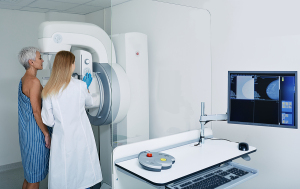by
John R. Fischer, Senior Reporter | March 14, 2023

The FDA is requiring mammography facilities to now begin including information on breast density in mammography reports for patients.
Over a decade after agreeing that women should be informed about breast density, the FDA has enacted regulatory updates that will require mammography facilities to do just this.
Published on March 9, the amendments to the
Mammography Quality Standards Act (MQSA) require these sites to include breast density information in reports following mammograms, including how density affects exam accuracy.
They create a “minimum” reporting standard that calls for specific language to explain the effects of breast density, as well as recommendations for patients to consult with their providers about their own breast density and risks for breast cancer, says the FDA.
Approximately half of women over 40 in the U.S. have dense breast tissue, which can obscure tumors on mammograms and also raises a woman's risk of developing breast cancer.
While the regulation requires information about breast density be included in mammography reports, it does not require facilities to inform women what specific category of breast density tissue they have. To date, only 13 states and Washington, D.C. do include this information in letters sent to women following mammograms.
“Though all states must now use the FDA language at a minimum, we hope those that already provide a woman’s specific density category will continue to include that information — and those that don’t will consider adding it, as it may influence decision-making,” JoAnn Pushkin, executive director of advocacy organization DenseBreast-info.org, told HCB News.
Over a decade in the making
About one in eight women will develop breast cancer in their lifetime, according to the Centers for Disease Control and Prevention, meaning that hundreds of thousands of Americans will be affected by the disease each year. The agency says that mammograms continue to be the best solution for screening and detection.
In 1992, Congress passed the Mammography Quality Standards Act (MQSA) to ensure patients had access to quality mammograms and information for detecting breast cancer in its earliest and most treatable stages. The law, which went into effect in 1994, gives the FDA oversight of mammography facilities, including accreditation, certification, annual inspections, and standards enforcement.
In 2011, Pushkin, along with other breast density advocates, testified before federal authorities that women needed to be made aware of the risks posed by breast density. An FDA advisory committee agreed.
In 2019, Congress
passed the Breast Density and Mammography Reporting Act, as part of the Fiscal Year 2020 Consolidated Appropriations Act. It called on the FDA to create a nationwide reporting standard that would require all mammography reports to include an assessment of breast density.
